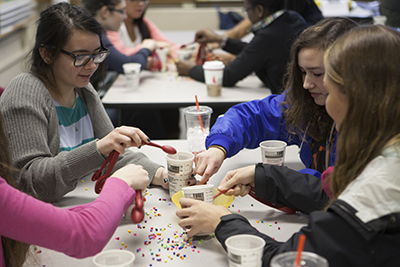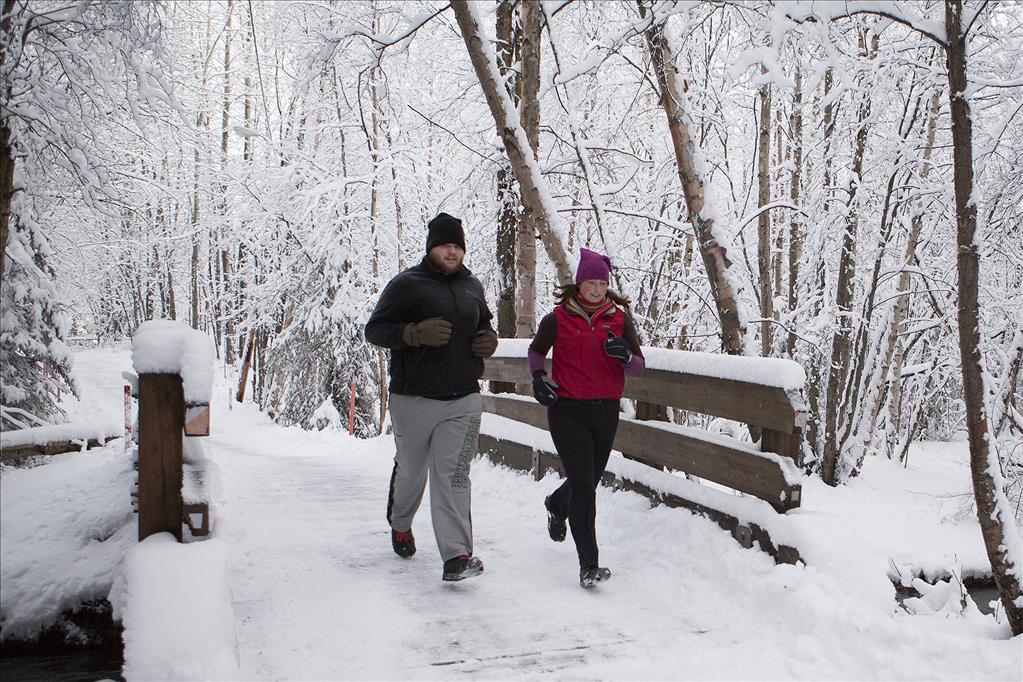UAA professor tracks Weddell seals in Antarctica
by Ted Kincaid |
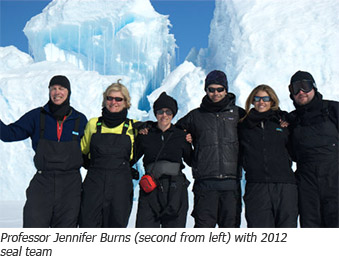
When UAA Professor Jennifer Burns heads south for the winter, she passes up all those typical snowbird stopping points in the milder climates for the chance to conduct field research in Antarctica. That's right, she trades a subarctic Anchorage in the winter (typically 5-30 degrees F) for McMurdo Station (10-30 degrees F) on the Ross Sea, where 24-hour Antarctic summer sunlight makes it possible to spend long days with the area's Weddell seals.
This past November, Professor Burns wrapped up the final field season of a three-year research project funded by the National Science Foundation (NSF). The three-part project includes collaborators at Old Dominion University in Virginia and University of California Santa Cruz (UCSC) in addition to UAA. Together their work will offer a more complete picture of Weddell seals living in the Ross Sea-how far they travel, when and where they go, their diving depths, foraging behaviors, surrounding sea temperatures and breeding success. The team's research is timely.
"There's a big push to make parts of the Ross Sea a marine reserve. It's largely considered to be one of the last intact marine ecosystems," says Burns. The Commission for the Conservation of Antarctic Marine Living Resources (CCAMLR), on which New Zealand and the U.S. play important roles, will be holding a special intercessional meeting in July to revisit proposed protections, including portions of the Ross Sea, that failed to garner unanimous support at their November 2012 annual meeting in Australia. Marine mammal research like the Burns-led Weddell project is important for international policy-making groups like CCAMLR to be able to base future protection decisions on scientific data.
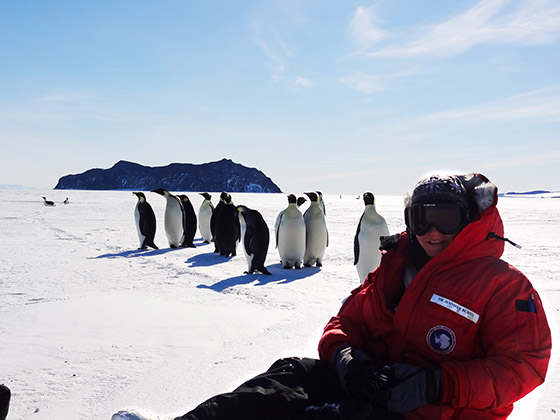
Curious Emperor penguins visited the researchers in the field.
Their research findings will also raise some questions about other species. Are the areas of the Ross Sea they identify as high-traffic seal foraging habitat also the areas preferred by whales? By penguins?
Seal team deploys and recovers tags, gains access to 100-year-old tissue samples from Shackleton and Scott expeditions
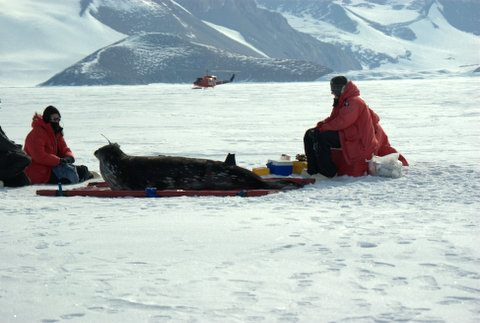
The team tags a seal while their taxi waits in the background.
Burns is studying the condition of the Weddell seals each field season and learning
the preferred foraging habitat of the seals-shallower areas near undersea canyons
where there's deep warmer water moving up, probably rich with nutrients. She is assisted
by Michelle Shero , a graduate student Burns has mentored since 2009 when she came to UAA through the
NSF Research Experience for Undergraduates program.
"I've been comparing this data with data we collected 20 years ago and seeing if we can detect behavioral differences in the animals now versus 20 years ago," says Burns, who began her work with Weddell seals in the 90s as a graduate student with the University of Alaska Fairbanks. "The big difference in the ecosystem there is that there's a fishery to the north that wasn't present 20 years ago." Specifically an Antarctic cod fishery. A prey fish for Weddell seals, Antarctic cod make a man-sized meal, reaching 175 pounds and nearly six feet in length.
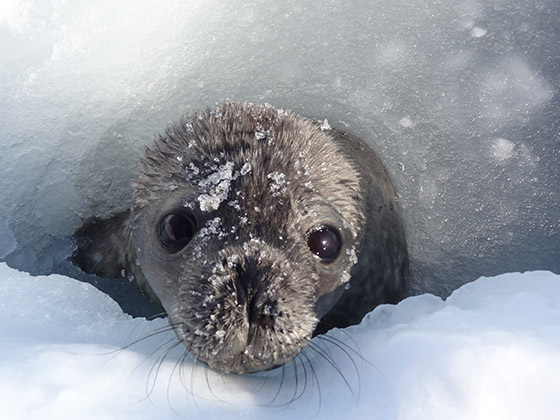
Weddell pup
In addition to the behavioral data from the '90s, Burns was able to gain access to
tissue samples from seals harvested by famed explorers Ernest Shackleton and Robert
Falcon Scott. Huts used by the explorers, which, awesomely, you can explore from the
comfort of your living room via Google's World Wonders project have been preserved in their up-and-left condition. The huts contain stacks of hides
and blubber from the expeditions. "They're basically sitting in a freezer," Burns
notes. So preservation hasn't been a problem. It took about 18 months to get permission
to take some small samples, though, going through all the proper channels. "We can
still run a stable isotope analysis on those old samples and see what the trophic
levels are-how high up on the trophic chain the animals were feeding." Those will
be compared with the samples from the '90s and samples from their most recent visits.
Getting 'tweets' from satellite-connected seals
The Old Dominion team is analyzing oceanographic data from the Ross Sea. "We've been
using our seals as little oceanographers to truth some ocean current models," Burns
says. The tagged Weddell seals' movements through the sea are recorded and relayed
via satellite from the transmitting tags affixed to their heads (tags are glued to
the animals' fur and are eventually recovered or shed during their annual molt). During
long, dark and icy Antarctic winters, traditional oceanographic data collection (boat,
satellite observation) are impossible, so letting the tags collect data as the animals
range throughout the sea is a clever way to learn about their wintertime habitat.
"The tags are very powerful little computers," says Burns. "They transmit through a satellite system, but the system they use to get the information out is really old, it's been around since the '80s. I think about the satellite tags on the seals' heads as being able to 'tweet' their information-it's very short bursts of information."
To transmit the information, the conditions have to be just right, though. "It only works if the animal is out of the water and if there is a satellite overhead. But the little computers also store everything. If we're able to recover the instrument, we get 100 percent of the data at really high resolution." That's 100 percent versus about 20 percent from the 'tweets,' she says.
The tag data includes dive depths, temperatures and salinity in addition to the location of the animal, but information is compressed and degraded to allow it to be sent quickly via the periodic satellite uplinks.
The tags also show seal location. The UCSC collaborators are studying the overwinter movements of the seals and they map the individual 'tweets' showing animal location to determine their routes and range.
"Getting the instrument back is particularly valuable because that 20 percent that
we get is not evenly spread," explains Burns. They get better information early in
the season before the tag antennas have been beaten up in the icy waters. "By about
July most antennas are in failure mode. So recovering the instrument really fills
in all the late season data, in particular."
Recovering a tag with Michelle Shero and UCSC grad student Kim Goetz.
One of the good things about working out of McMurdo Station, Burns says, is, in addition
to the great support from station staffers, research teams look out for each other.
Two of their tags were recovered and returned to them by other teams. They're often
able to return the favor. Most of the Weddell seals in the area are flipper-tagged
with a unique ID as pups, so putting out an APB on an animal among the other teams
can make locating your target a little simpler.
Meanwhile, back at the lab...
Now back in (still-wintry) Anchorage, Burns will be returning to the classroom and
spending time in the laboratory with Shero. Samples from their final field season
made their way back to Anchorage just before winter break, so they have their lab
work cut out for them this spring semester.
Burns is also busy working to analyze data from another research project closer to home: the freshwater Lake Iliamna seal population. Collaboration with local agencies, anthropologists and Lake Illiamna-area village residents have created a hybrid scientific-analysis-plus-Alaska-Native-traditional-knowledge picture of the unique seal population.
Is there more Antarctic seal research in the works? Definitely. Burns has submitted another NSF proposal for a related project and is awaiting the final decision on funding.
To learn more about Antarctic Weddell seal research, visit the PolarTREC website , where elementary and middle school teacher Alex Eilers, who accompanied Burns and team on their February 2012 expedition, posted photos, journals and lessons for students.
 "UAA professor tracks Weddell seals in Antarctica" is licensed under a Creative Commons Attribution-NonCommercial 4.0 International License.
"UAA professor tracks Weddell seals in Antarctica" is licensed under a Creative Commons Attribution-NonCommercial 4.0 International License.











